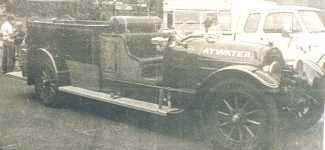1902
[None]
1903
[None]
1904
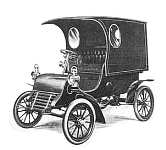
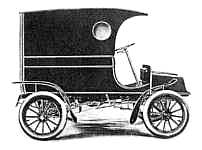
Were these the venerable ancestors of today's
Cadillac Escalade wagon?
On the left, the so-called Model A Delivery
with detachable top, costing $850; on the right,
the so-called Model B Delivery with fixed
top, costing $900; the latter was, according to the 1904
product brochure, the ideal vehicle for the
merchant who is tired of using three men
and as many horses for the work that can be done
better by one man and a Cadillac."
1905
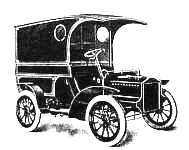
This Model F Delivery wagon is the first
Cadillac ever to be designated as a commercial car
At $950 it was very popular with merchants around the country; one buyer calculated
that in just twenty weeks of use his van had saved him almost $600 over a
horse-drawn vehicle; the standard color was maroon
[Unknown, USA] Light-duty wagon on Model F chassis for U.S. armed
forces; photo McC, p.17
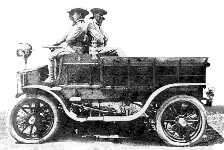
[Unknown, UK?] Taxi limousine. This Model "F" touring
car has been converted to an enclosed limousine (taxi). I believe it was in operation in
the United Kingdom, in the early part of this century; it may still be in existence.
The front and rear mudguards also are non original
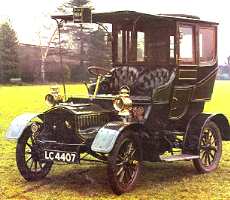
1906
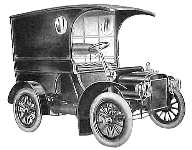
The 1906 Cadillac line was rounded out by
this sturdy Model M delivery van.
[Unknown, USA] Light-truck, probably on Model F chassis [details
unclear from small photo, below]. It has the "Cadillac" script scrolled across
the sides.

1907

The 1907 Model M delivery van remained
basically unchanged from the previous year.
Priced at $950 it was the favorite of Detroit
tradespeople.
1908

The Model M Delivery wagon was carried through from
the 1907 line; it sold for $950.
It retained the wheel base of 76 inches which gave it great
maneuverability
The standard colors for this car in 1908 were Brewster green for the body panels and
the
frame side bars and red for the wheels and axles, with black and gold striping
[Unknown, USA] Custom Model G [???] limousine; photo McC,
p.34. This custom taxi is identified as 1907-08 Model G, but the hood appears too short to
accommodate the standard 4-cyl. engine. Perhaps it was fitted with a single-cylinder motor
for city driving.
1909
1910
[Unknown, USA] Fire-Chief runabout, McC, p.41
[Unknown, USA] Converted car, for railroad inspection
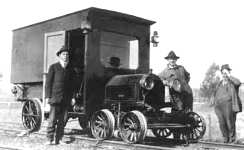
1911
1912
1913
Holmes (USA) Cadillac wrecker (built 1916), McC, p.53 [may
be at International Towing and Recovery, Hall of Fame, Chattanooga, TN]. Yes,
the very first tow truck WAS a Cadillac. In 1916, John Wiley, a business school operator,
dumped his Model T upside down in a ditch. It took a day and six men to get it out. One of
the men, Ernest Holmes, a student of Wiley's school, thought there had to be a better way.
He mounted three poles to the frame of a 1913 Cadillac, added a pulley and ran a chain
through it. He patented his invention and during WW2 his company provided more than 7,000
tow trucks to the Allies. His shop was in Chattanooga, Tennessee, and recently a group
called "Friends of Towing" opened the International Towing and Recovery Hall of
Fame and Museum a few blocks from his shop. In the 1930s and 1940s, an old car was exactly
that, something to be sold cheap as winter transportation, or crushed. A lot of big, heavy
cars ended up as tow trucks. Cadillacs were very popular as tow trucks.
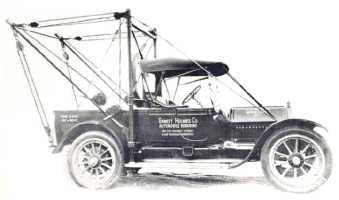
Hoover Wagon Co (USA) Custom Cadillac hearse, photo McC
p.53.
[Unknown, USA] Custom police paddy-wagon on Cadillac chassis
[photo NAHC, Detroit in OCW 22.8.91].
1914
[Unknown, USA] Custom Fire-Chief runabout, McC, p.55
[Unknown, USA] Custom railroad inspection car, McC, p.56
[Unknown, USA] Custom "bus" on Cadillac chassis (photo NAHC,
Detroit in OCW 22.8.91).
1915
Geissel (USA) Custom hearse, McC,
p.60. A Cadillac hearse with 4-column carved side panels was offered for sale [on the
Internet], in August 1996, both by Bennett Funeral Coaches in Michigan and by the Kruse
auction company. It was listed as a 1916 model, so there may have been two.
Kimball, C.P. (Chicago, IL, USA) I
remember seeing this custom Cadillac "bus" on a 145" wheelbase chassis, in
unrestored condition, in a club magazine, around 1972. Someone must have taken on
the arduous task of restoring it for here it is, like new. It was advertized for
sale in Hemmings Motor News (Internet site) in October, 2008. From the license tags, it
appears to be registered in the UK.
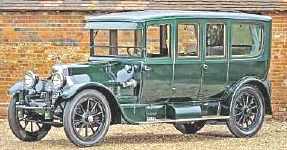
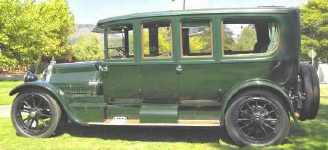
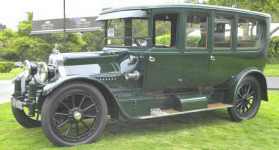
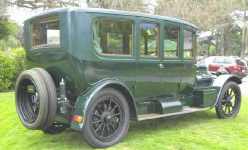
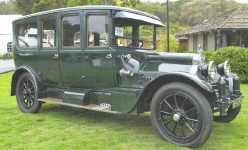
[ Four fall pics are courtesy of Philippe Hulet de
Limal, a Belgian member of the American Car Club be France ]
Kingsbury-Leahy (USA) Partners Edward W. Leahy and S.
Kingsbury organized the Kingsbury-Leahy Co in 1912 (for $40,000 in capital stock) to build
carriages, auto bodies and a motor car called the Kingsbury. Manufacture of the car is
doubted, but apparently some automobile bodies and carriages were produced. Here is a
Cadillac hearse mounted on a one-ton Garford chassis. This was offered by the
Kingsbury Leahy Company of Albany, NY. The net cost of the rig was $1200 in 1915. It was
not precisely to the client's specifications; these were as follows: Loading space
7'10" by 3'7". Body to be of selected hardwood frame, body metal to be securely
fastened under moldings, to have cast aluminum carved strips and pillars on sides and back
door, to have bevel edge plate glass in sides with removable sunburst draperies (color
optional, black, purple or silver gray), to have dome light inside controlled by
push-button switches, one at driver's seat, with frameless top glass, to have double doors
on rear properly hinged and locked, with hearse table, with rollers and pins and long
roller on rear end of table. Inside to be lined flush and finished in mahogany or rubbed
black, to have folding chair inside securely fastened, to have one folding seat inside and
folding step in rear. Sides of body below chair rack can be covered with Lin Rubber if
desired. To have ventilating Limousine glass front, pillar lamps and name plates. Painted,
color optional, except white. To have space for extra tire either under body or on side of
car.
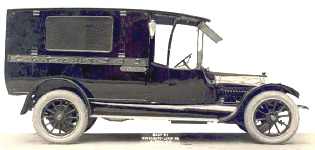
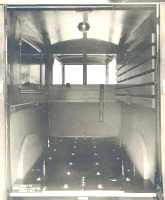
[Unknown, USA] Custom "Paddy wagon", McC, p.60
[Unknown, USA] Cadillac armored car, McC, p.60
1916
Geissel (USA) 8-column, carved panel hearse, wood spoke wheels,
four carriage lamps [offered for sale, 1996, by Bennet Funeral Coaches, MI, USA] - may be
the same car as the 1915 model listed above and shown in McC, p.60
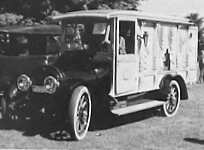
Is THIS the hearse in question ?
Owen (USA) hearse, McC, p.64
Seaman (USA) Custom ambulance
[Unknown, USA] Custom police patrol car, McC, p.64
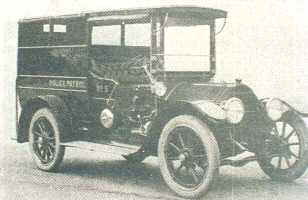
[Unknown, USA] Custom fire truck on Cadillac chassis [photo OCW
22.8.91]
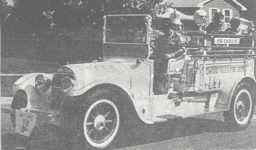
1917
Hoover Wagon (USA) Custom ambulance, McC, p.69
Northern Pump Co. (USA) Custom fire car by McC, p.69
1918
Hess & Eisenhardt (USA) Custom, carved-side hearse
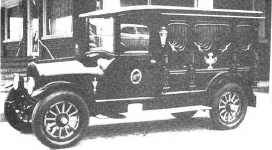
[Unknown, USA] Artillery tractor, WW1
[Unknown, USA] Searchlight car, WW1
[Unknown, USA] Balloon winch, WW1
[Unknown, USA] Railroad track inspection car, McC, p.71; SS
6/92, p.3
1919
Holmes (USA) èsee 1913, above] This Cadillac wrecker is
believed to have been built circa 1919-20 [the iamge is identified as a 1920 Holmes Tow
Truck]. The very first tow truck WAS a Cadillac. In 1916, John Wiley, a business
school operator, dumped his Model T upside down in a ditch. It took a day and six men to
get it out. One of the men, Ernest Holmes, a student of Wiley's school, thought there had
to be a better way. He mounted three poles to the frame of a 1913 Cadillac, added a pulley
and ran a chain through it. He patented his invention and during WW2 his company provided
more than 7,000 tow trucks to the Allies. His shop was in Chattanooga, Tennessee, and
recently a group called "Friends of Towing" opened the International Towing and
Recovery Hall of Fame and Museum a few blocks from his shop. In the 1930s and 1940s, an
old car was exactly that, something to be sold cheap as winter transportation, or crushed.
A lot of big, heavy cars ended up as tow trucks. Cadillacs were very popular as tow
trucks.
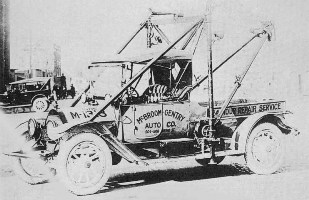
[ Image: Z. Taylor Vinson collection, courtesy
Hagley Library and Museum, DE ]
[Unknown] (Switzerland) Custom fire truck
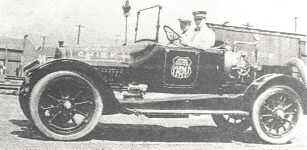
[Unknown, USA] Special Cadillac coach, SIA 66, p.34.
[Unknown, USA] Custom fire-truck, Atwater community (Oregon?)
[photo OCW, 22.8.91]
